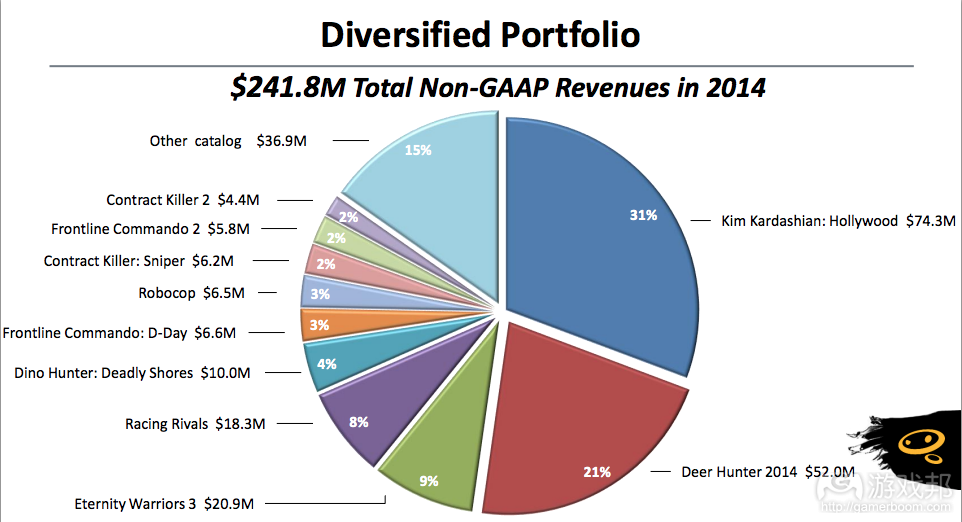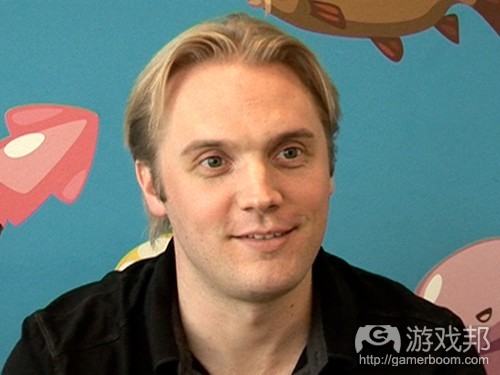每日观察:关注Glu 2014年度营收2.418亿美元2.05
1,据gamesindustry的消息称Glu发布Q4财报,营收7620万美元。
2014全年营收2亿4180万美元。其中Kim Kardashian: Hollywood一款游戏贡献7430万美元,Deer Hunter 2014为5200万美元、Eternity Worriors 3为2090万美元、Robocop为650万 美元。
2,据gamasutra的消息称知名游戏开发者Brenda Romero在DICE Summit提出了一个超级问题:What does a great game look like?一款伟大的游戏应该是什么样子的。
而结论是:A great game is about how it makes you feel。如果按照这个论断的话,大部分的开发者都会自我感觉良好,然后是不是都是不俗的游戏?
3,据gamasutra的消息称Kristian Segerstrale在该网站撰文谈游戏成功的十条规则,诸如:要有耐心。
Kristian Segerstrale应该是这几年游戏圈连续成功的典型:Macrospace / Glu Mobile联合创始人、Playfish联合创始人、EA数字部门的EVP(Playfish出售后)、Supercell董事 成员、Super Evil(Vainglory开发商)COO。(本文由游戏邦编译,转载请注明来源,或咨询微信zhengjintiao)
1,Today Glu, creators of the wildly successful Kim Kardashian: Hollywood, announced its Q4 earnings had outperformed previous guidance and that it expected to continue its success with the signing of a new five year deal with Katy Perry.
Glu’s Non-GAAP revenues for the Q4 period stood at $76.2 million, up 78 per cent year-on-year and Non-GAAP net income was $12.2 million compared to $5.6 million for Q4 2013.
Total GAAP revenue was $72.9 million for Q4 of 2014 compared to $34.8 million for the same period in 2013. GAAP net income was $1.4 million for Q4 2014 compared to a GAAP net loss of $(3.5) million for Q4 of 2013
Cash flows generated from operations were $19.3 million for Q4 2014 compared to $1.9 million generated for the fourth quarter of 2013.(source: gamesindustry.biz)
2,”What does a great game look like?”
That’s the question that game development veteran Brenda Romero asked herself during a talk at today’s DICE Summit in Las Vegas.
If you ask 10 game developers, you might get 10 different answers. For some it looks like a work of art. For some it’s a pile of money. For some, it looks like innovation, she said.
Before offering up her answer to “what does a great game look like?” she talked about the two measures of quality that games had when she joined the game industry in 1981.
First: the size of the game manual. If a manual was able to make the game’s box feel like a ton of bricks, that’s a good game. This assertion was met with laughter, from her and the audience, but there was definitely truth to it.
Secondly, and more to the point of her talk, were “amazing graphics.” “Amazing graphics” were one of the two ways that players would judge a game’s quality, the play itself be damned.
Having worked on Wizardry VII, an RPG that was critically-acclaimed, Romero recalled what she identified as a sea change in game visuals, brought on by Cyan’s Myst and id’s Doom. The advancement was, in a way, intimidating, in that those games had such an incredible emphasis on those “amazing graphics” (on top of good play).
“I remember seeing those two games and thinking the industry took a massive graphics leap,” she said. “It felt like a bomb went off…that graphics were king.”
She said players were coming to the point where if the graphics “sucked,” they assumed the game sucked as well.
Romero confessed she did an experiment with her daughter, who was born in 2001. As her child grew up in a home of games and game creation, she made a point never to equate graphics with a game’s quality. She wanted to see if play would speak for the game’s quality.
It was Minecraft, with its blocky graphics, paired with incredibly creative play that engaged her children so positively, that proved to Romero that the idea of “amazing graphics = amazing game” is simply a sentiment imposed by a tech-obsessed game dev culture. “Once she got to Minecraft, graphics didn’t matter,” Romero determined.
So what does a great game look like, then? “For me, a great game is all about how it makes you feel,” she said.
Even players who may have always cared about amazing graphics must realize that their imaginations supplement the experience. The halls of Zork and the house in Alone in the Dark are much more vivid in our imaginations than they ever were on the screen. (Just look at those old games that you loved that had “amazing graphics” at the time.) Players more accurately recall the wonderful feel of a “great looking game,” than the actual graphics.
“Our memory and imagination of a game and how it makes us feel can alter our memory over time,” she said.
Romero talked about a recent workshopping experience with young game designers, who she tasked to make a fully-functional tabletop RPG in two hours. She saw imaginations explode, and she saw intense creativity. The games weren’t visually appealing…just some markers, paper, a few game pieces and some dice. But in their own special way, were “great-looking games.”
So again – what does a great game look like? “For me, it’s not on the screen, it’s on the faces of players…being able to see them. And on the faces of game creators.”
“I feel like the designer … and the player — we’re almost mirrors of one another, and there’s this computer in the middle that acts as the border between the two.”
“[Players] are a mirror of us, and we are a mirror of them,” she said. “Ultimately, we are what makes a game great. And we are what great games look like.”( source:gamasutra.com )
3,Keep burn rates low + embrace the medium
When the conditions are tough and you’re just getting your company off the ground in a new market, keep your burn rate low; spend a minimum amount of money. Segerstrale said it’s better to have a small team working in a medium for a long time, instead of a big team burning up money in a short period of time.
Compound market immaturity = slow growth
If you’re involved in tech that’s immature, and your market is immature as well, you have to understand that traction will take a long time to happen.
He explained how he’d predicted that mobile games would eventually see a billion-dollar game company in 2004 — that didn’t happen until nearly a decade later. These things take time, but that early experience in the immature feature phone market helped him immensely once smartphones took off.
If you want to IPO your game biz, make sure you don’t do it right after your first big growth curve
Segerstrale didn’t suggest that everyone puts their game company up for an IPO. But if you do, you need to experience how to handle the downturns; how to explain to investors and analysts the trends of your company. Know the ups and downs of your company and your marketplace before going public.
(He also joked about how Glu’s stock jumped 4 percent after he left the company — at least the market agreed with his decision, he said.)
There’s no publishing leverage in a digital channel
In physical games, it’s a 50/50 split between making a game and distributing them. In digital, it’s 90 percent making games, with 10 percent left to publishing (i.e. traditional marketing). Don’t invest too much in publishing if you’re in digital.
Selling your company ends one adventure and starts a new one
After selling Playfish to EA, he was a non-executive director at Supercell, which turned into a huge success with Clash of Clans. Now he’s heading up Super Evil Megacorp working on the tablet MOBA Vainglory. Apply your past learnings to your new adventures, and be prepared to learn even more.
Talent density matters
“Talent matters,” stressed Segerstrale. He said that talent ought to be dense; Supercell’s structure shows that 10 amazing people working on one game is better than having 10 amazing people forming 10 different teams to work on 10 different games. Be dense, be efficient, be successful.
Touch screens are already for “core” audiences
There are a lot of assumptions about what mobile players want, or how they play games. Many say they want simpler, three-minute experiences. But with a MOBA like Vainglory, Segerstrale said it goes against assumptions of mobile players. “Core” players are waiting for “core” experiences on touchscreens, he said.
Be patient
Hearkening back to point no. 2, he said to be patient. Use slow growth as an opportunity to learn. The people who cut their teeth when times are tough are the leaders when things take off.
Funding models must evolve
This isn’t traditional game development and marketing anymore, so there’s no reason game developers should be emphasizing traditional funding models.
Don’t listen to established wisdom
“Take established wisdom with a massive bowl of salt,” Segerstrale said. “Don’t listen to me. Just go out and build it. That’s what’s so exciting about today.”(source:gamasutra.com )










































 闽公网安备35020302001549号
闽公网安备35020302001549号